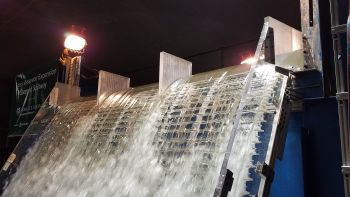Physical Models: Difference between revisions
(Created page with "__NOTOC__ ---- <!-- Delete any sections that are not necessary to your topic. Add pictures/sections as needed --> Physical models have successfully been used for decades and are tried and proven in their effectiveness. Physical models help in predicting the performance of the eventual prototype using appropriate scaling factors to observed flow quantities to compensate for scaling effects. Physical models help to visualize and identify any potential future constructio...") |
No edit summary |
||
| (7 intermediate revisions by 4 users not shown) | |||
| Line 1: | Line 1: | ||
__NOTOC__ | __NOTOC__ | ||
[[Category:3D Hydraulic Models]] | |||
---- | ---- | ||
{{Picture | |||
<!-- Add image file name (ex.image.jpg) --> | |||
|image= Gross.jpg | |||
<!-- Add picture caption --> | |||
|caption= Physical model of the stepped spillway for the Gross Reservoir Expansion project. | |||
(Image Source: CO DWR) | |||
}} | |||
<!-- Delete any sections that are not necessary to your topic. Add pictures/sections as needed --> | <!-- Delete any sections that are not necessary to your topic. Add pictures/sections as needed --> | ||
Physical models have successfully been used for decades and are tried and proven in their effectiveness. Physical models help in predicting the performance of the eventual prototype using appropriate scaling factors to observed flow quantities to compensate for scaling effects. | Physical models have successfully been used for decades and are tried and proven in their effectiveness. Physical models help in predicting the performance of the eventual prototype using appropriate scaling factors to observed flow quantities to compensate for scaling effects. | ||
Physical models help to visualize and identify any potential future construction or operational concerns in real time, are simpler than numerical models (not prone to incorrect application of turbulence modeling techniques), and foster collaboration between engineering disciplines. Once a physical model is constructed, a range of flow conditions can be simulated in a short period of time compared to the solve time of a single flow condition using a numerical model. | Physical models help to visualize and identify any potential future [[construction]] or operational concerns in real time, are simpler than numerical models (not prone to incorrect application of turbulence modeling techniques, like [[Computational Fluid Dynamics (CFD)|computational fluid dynamics]]), and foster collaboration between [[engineering]] disciplines. Once a physical model is constructed, a range of flow conditions can be simulated in a short period of time compared to the solve time of a single flow condition using a numerical model. | ||
The challenges associated with physical models include the required time and resources associated with building and housing the model. The facilities or organizations that possess the capability of performing such work can be limited and | The challenges associated with physical models include the required time and resources associated with building and housing the model. The facilities or organizations that possess the capability of performing such work can be limited and traveling to observe the [[operation]] of the model is typically necessary. Once data is collected, changing the design of the model can require additional time and resources. Additionally, physical models are typically dismantled to make room for new models, reducing the available window to collect additional data when compared to a numerical model. | ||
==Trainings== | ==Trainings== | ||
{{Video Icon}} | {{Video Icon}} [[On-Demand Webinar: Introduction to Physical Modeling of Spillways for Dams]] | ||
<!-- For information on notation for in text citations visit https://www.mediawiki.org/wiki/Help:Cite Or simply enclose the citation as shown <ref> citation </ref> in the location of the in text mention. Citations will automatically populate below--> | <!-- For information on notation for in text citations visit https://www.mediawiki.org/wiki/Help:Cite Or simply enclose the citation as shown <ref> citation </ref> in the location of the in text mention. Citations will automatically populate below--> | ||
Latest revision as of 16:15, 25 July 2023

|
| Physical model of the stepped spillway for the Gross Reservoir Expansion project.
(Image Source: CO DWR) |
Physical models have successfully been used for decades and are tried and proven in their effectiveness. Physical models help in predicting the performance of the eventual prototype using appropriate scaling factors to observed flow quantities to compensate for scaling effects.
Physical models help to visualize and identify any potential future construction or operational concerns in real time, are simpler than numerical models (not prone to incorrect application of turbulence modeling techniques, like computational fluid dynamics), and foster collaboration between engineering disciplines. Once a physical model is constructed, a range of flow conditions can be simulated in a short period of time compared to the solve time of a single flow condition using a numerical model.
The challenges associated with physical models include the required time and resources associated with building and housing the model. The facilities or organizations that possess the capability of performing such work can be limited and traveling to observe the operation of the model is typically necessary. Once data is collected, changing the design of the model can require additional time and resources. Additionally, physical models are typically dismantled to make room for new models, reducing the available window to collect additional data when compared to a numerical model.
Trainings
![]() On-Demand Webinar: Introduction to Physical Modeling of Spillways for Dams
On-Demand Webinar: Introduction to Physical Modeling of Spillways for Dams
Citations:
Revision ID: 7454
Revision Date: 07/25/2023
